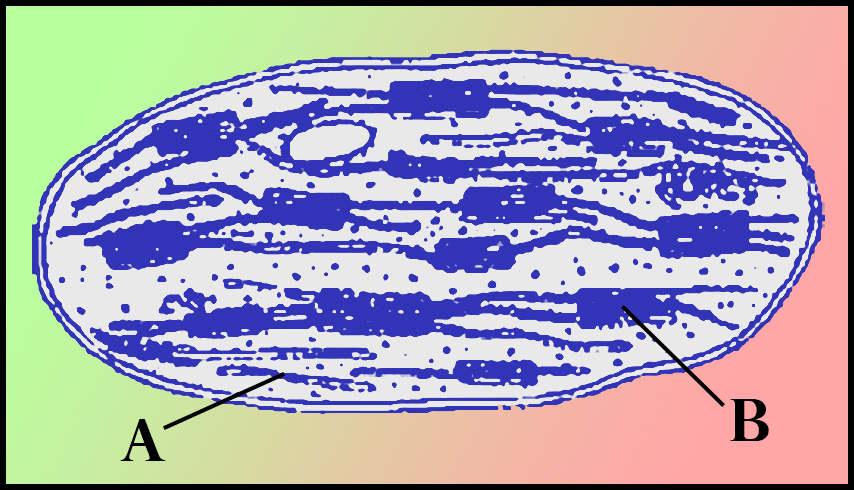
Identify A and B in the given figure and select the correct option:

(a) A - Grana thylakoid; B - Stroma Thylakoid
(b) A - Stroma Thylakoid; B - Grana thylakoid
(c) A - Granum; B - Stroma
(d) A - Stroma; B - Granum

Answer
574.8k+ views
Hint: In photosynthetic eukaryotes, the photosynthesis occurs in the subcellular organelle known as chloroplast. This double- membrane enclosed organelle possesses a third system of membranes called thylakoids which can be further of two types.
Complete Step by Step Answer: The given diagram is a representation of a part of chloroplast showing: - A - Stroma Thylakoid - B - Grana Thylakoid
- A stack of thylakoids forms a granum. - Adjacent grana are connected by the unstacked membrane- bound extensions called stroma lamellae. - Photosynthesis takes place in the green leaves of plants and other green parts of the plants like the stem, etc. The highest photosynthetic activity in higher plants is seen in the mesophyll of leaves.
- The mesophyll cells possess many chloroplasts, which contain the specialized light- absorbing green pigments called the chlorophylls.
- Thylakoids are membrane- bound compartments present inside the chloroplasts and cyanobacteria. They are the sites where the light- dependent reactions of photosynthesis take place.
- These thylakoids consist of a thylakoid membrane that surrounds a thylakoid lumen and they are stacked to form grana and individual grana is separated by stroma.
So, the correct answer is, ‘(b) A - Stroma Thylakoid; B - Grana thylakoid’
Note: - The fluid that surrounds the thylakoids, is called the stroma. - In certain $ { C }_{ 4 }$ plants and some algae the thylakoids are not arranged in the stack. They are rather present as free- floating structures. - These thylakoid membranes are the places for the photosystem activity which is the mainstay of photosynthesis.
Recently Updated Pages
Why are manures considered better than fertilizers class 11 biology CBSE

Find the coordinates of the midpoint of the line segment class 11 maths CBSE

Distinguish between static friction limiting friction class 11 physics CBSE

The Chairman of the constituent Assembly was A Jawaharlal class 11 social science CBSE

The first National Commission on Labour NCL submitted class 11 social science CBSE

Number of all subshell of n + l 7 is A 4 B 5 C 6 D class 11 chemistry CBSE

Trending doubts
10 examples of friction in our daily life

One Metric ton is equal to kg A 10000 B 1000 C 100 class 11 physics CBSE

Difference Between Prokaryotic Cells and Eukaryotic Cells

1 Quintal is equal to a 110 kg b 10 kg c 100kg d 1000 class 11 physics CBSE

State the laws of reflection of light

Explain zero factorial class 11 maths CBSE




